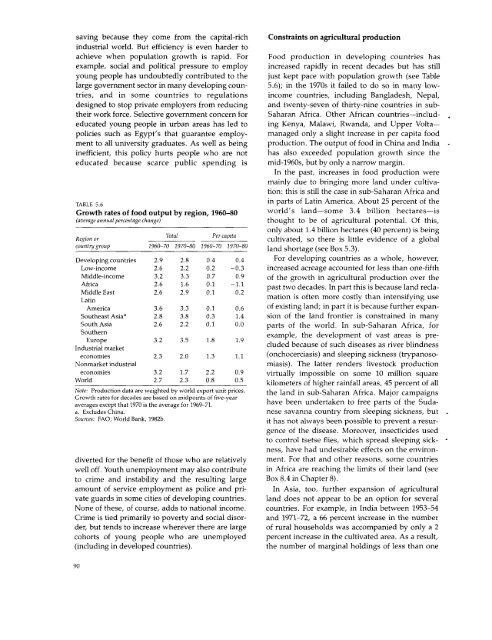World Development Report 1984
World Development Report 1984
World Development Report 1984
You also want an ePaper? Increase the reach of your titles
YUMPU automatically turns print PDFs into web optimized ePapers that Google loves.
saving because they come from the capital-rich Constraints on agricultural production<br />
industrial world. But efficiency is even harder to<br />
achieve when population growth is rapid. For Food production in developing countries has<br />
example, social and political pressure to employ increased rapidly in recent decades but has still<br />
young people has undoubtedly contributed to the just kept pace with population growth (see Table<br />
large government sector in many developing coun- 5.6); in the 1970s it failed to do so in many lowtries,<br />
and in some countries to regulations income countries, including Bangladesh, Nepal,<br />
designed to stop private employers from reducing and twenty-seven of thirty-nine countries in subtheir<br />
work force. Selective government concern for Saharan Africa. Other African countries-includeducated<br />
young people in urban areas has led to ing Kenya, Malawi, Rwanda, and Upper Voltapolicies<br />
such as Egypt's that guarantee employ- managed only a slight increase in per capita food<br />
ment to all university graduates. As well as being production. The output of food in China and India<br />
inefficient, this policy hurts people who are not has also exceeded population growth since the<br />
educated because scarce public spending is mid-1960s, but by only a narrow margin.<br />
In the past, increases in food production were<br />
mainly due to bringing more land under cultivation:<br />
this is still the case in sub-Saharan Africa and<br />
TABLE 5.6 in parts of Latin America. About 25 percent of the<br />
Growth rates of food output by region, 1960-80 world's land-some 3.4 billion hectares-is<br />
(average annual percentage change) thought to be of agricultural potential. Of this,<br />
Total Per capita only about 1.4 billion hectares (40 percent) is being<br />
Region or Percapita cultivated, so there is little evidence of a global<br />
country group 1960-70 1970-80 1960-70 1970-80 land shortage (see Box 5.3).<br />
Developing countries 2.9 2.8 0.4 0.4 For developing countries as a whole, however,<br />
Low-income 2.6 2.2 0.2 -0.3 increased acreage accounted for less than one-fifth<br />
Middle-income 3.2 3.3 0.7 0.9 of the growth in agricultural production over the<br />
Africa 2.6 1.6 0.1 -1.1 past two decades. In part this is because land recla-<br />
Middle East 2.6 2.9 0.1 0.2 mation is often more costly than intensifying use<br />
Latin<br />
America 3.6 3.3 0.1 0.6 of existing land; in part it is because further expan-<br />
Southeast Asiaa 2.8 3.8 0.3 1.4 sion of the land frontier is constrained in many<br />
South Asia 2.6 2.2 0.1 0.0 parts of the world. In sub-Saharan Africa, for<br />
Southern example, the development of vast areas is pre-<br />
Europe 3.2 3.5 1.8 1.9 cluded because of such diseases as river blindness<br />
Industrial market<br />
economies 2.3 2.0 1.3 1.1 (onchocerciasis) and sleeping sickness (trypanoso-<br />
Nonmarket industrial miasis). The latter renders livestock production<br />
economies 3.2 1.7 2.2 0.9 virtually impossible on some 10 million square<br />
<strong>World</strong> 2.7 2.3 0.8 0.5 kilometers of higher rainfall areas, 45 percent of all<br />
Note: Production data are weighted by world export unit prices. the land in sub-Saharan Africa. Major campaigns<br />
Growth rates for decades are based on midpoints of five-year<br />
averages except that 1970 is the average for 1969-71. have been undertaken to free parts of the Sudaa.<br />
Excludes China. nese savanna country from sleeping sickness, but<br />
Sources: FAO; <strong>World</strong> Bank, 1982b. it has not always been possible to prevent a resur-<br />
gence of the disease. Moreover, insecticides used<br />
to control tsetse flies, which spread sleeping sickness,<br />
have had undesirable effects on the environdiverted<br />
for the benefit of those who are relatively ment. For that and other reasons, some countries<br />
well off. Youth unemployment may also contribute in Africa are reaching the limits of their land (see<br />
to crime and instability and the resulting large Box 8.4 in Chapter 8).<br />
amount of service employment as police and pri- In Asia, too, further expansion of agricultural<br />
vate guards in some cities of developing countries. land does not appear to be an option for several<br />
None of these, of course, adds to national income. countries. For example, in India between 1953-54<br />
Crime is tied primarily to poverty and social disor- and 1971-72, a 66 percent increase in the number<br />
der, but tends to increase wherever there are large of rural households was accompanied by only a 2<br />
cohorts of young people who are unemployed percent increase in the cultivated area. As a result,<br />
(including in developed countries). the number of marginal holdings of less than one<br />
90









